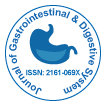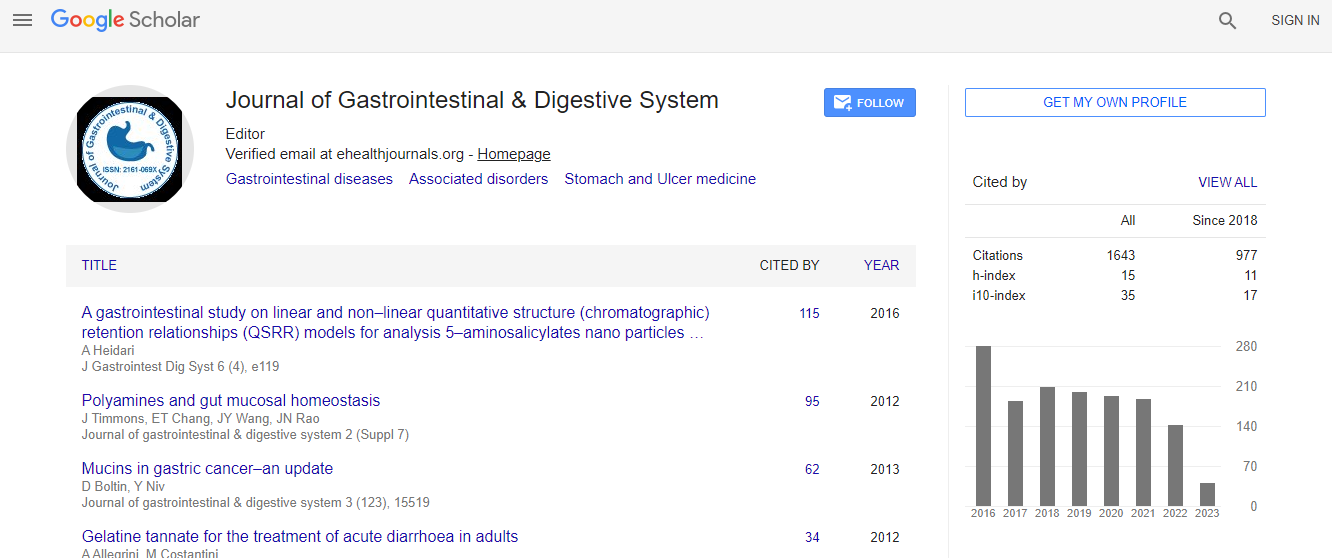Our Group organises 3000+ Global Conferenceseries Events every year across USA, Europe & Asia with support from 1000 more scientific Societies and Publishes 700+ Open Access Journals which contains over 50000 eminent personalities, reputed scientists as editorial board members.
Open Access Journals gaining more Readers and Citations
700 Journals and 15,000,000 Readers Each Journal is getting 25,000+ Readers
Google Scholar citation report
Citations : 2091
Journal of Gastrointestinal & Digestive System received 2091 citations as per Google Scholar report
Journal of Gastrointestinal & Digestive System peer review process verified at publons
Indexed In
- Index Copernicus
- Google Scholar
- Sherpa Romeo
- Open J Gate
- Genamics JournalSeek
- China National Knowledge Infrastructure (CNKI)
- Electronic Journals Library
- RefSeek
- Hamdard University
- EBSCO A-Z
- OCLC- WorldCat
- SWB online catalog
- Virtual Library of Biology (vifabio)
- Publons
- Geneva Foundation for Medical Education and Research
- Euro Pub
- ICMJE
Useful Links
Recommended Journals
Related Subjects
Share This Page
Endoscopic management of gastro-esophageal reflux disease GERD
International Conference on Digestive Diseases
Hesham Elsawah
Egypt Air Hospital, Egypt
Posters & Accepted Abstracts: J Gastrointest Dig Syst
Abstract
Gastro-esophageal reflux disease (GERD) is a complex disorder resulting from multiple contributing factors, including acid production, lower esophageal sphincter tone and location, and anatomic barriers to reflux created by the angle of His and the diaphragmatic hiatus ,The high prevalence of (GERD) together with drug dependence , intolerance and side effects was the driving force for development of interventional procedures . The laparoscopic fundoplication was the only option for many years inspite being unfavorable by the patients. The unchallenged practice released many reports of various types of complications and unwanted results. That paved the way for emerging of less invasive trance-oral endoscopic procedures for (GERD). The three available competing technics is Stretta . Esophyx and MUSE . Every procedure is evolved during the last years into new generations with more safety and efficacy after many modifications in precision. Size and quality of tool .the decision to do endoscopic management and choosing between the available procedures should be perfectly tailored to individual patients. The interpretation of symptomatology score and Endoscopic findings together with high resolution manometry HRM and 24 hour impedance PH metry results decides the treatment path for the patients. A major guidelines shift occurred in the last years towards endoscopic management of GERD .some limitations have been set for such managements as the age and size of hiatus hernia, however defective esophageal clearance is not very much an obstacle as in the case of Nissen fundoplication. Many factors affecting the contradicting outcome reports about efficacy of each procedure, collecting subjective and objective measurements for every procedure will help for prioritization and sitting standards of care for GERD, the procedures have financial obstacles towards wide range application for patients.Biography
Email: hesham.elsawah@gmail.com

 Spanish
Spanish  Chinese
Chinese  Russian
Russian  German
German  French
French  Japanese
Japanese  Portuguese
Portuguese  Hindi
Hindi 
